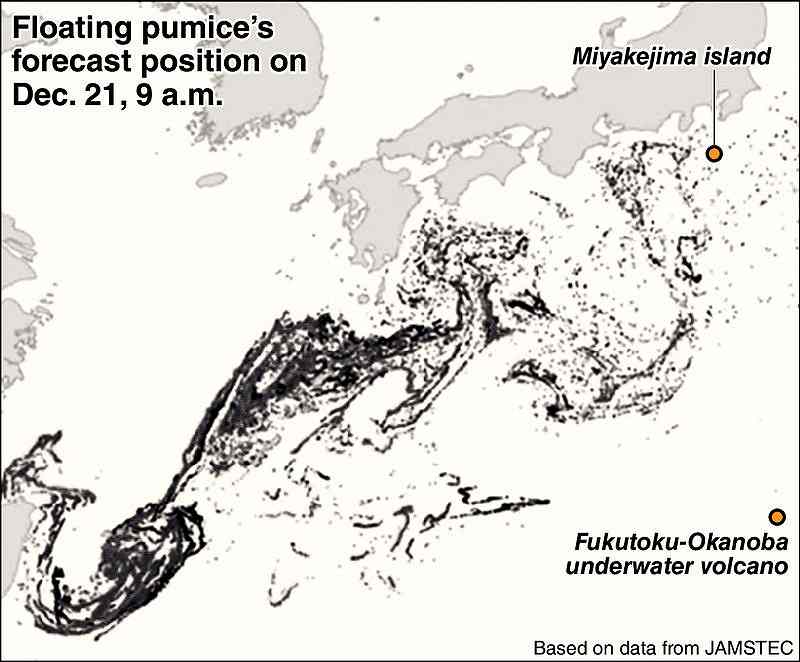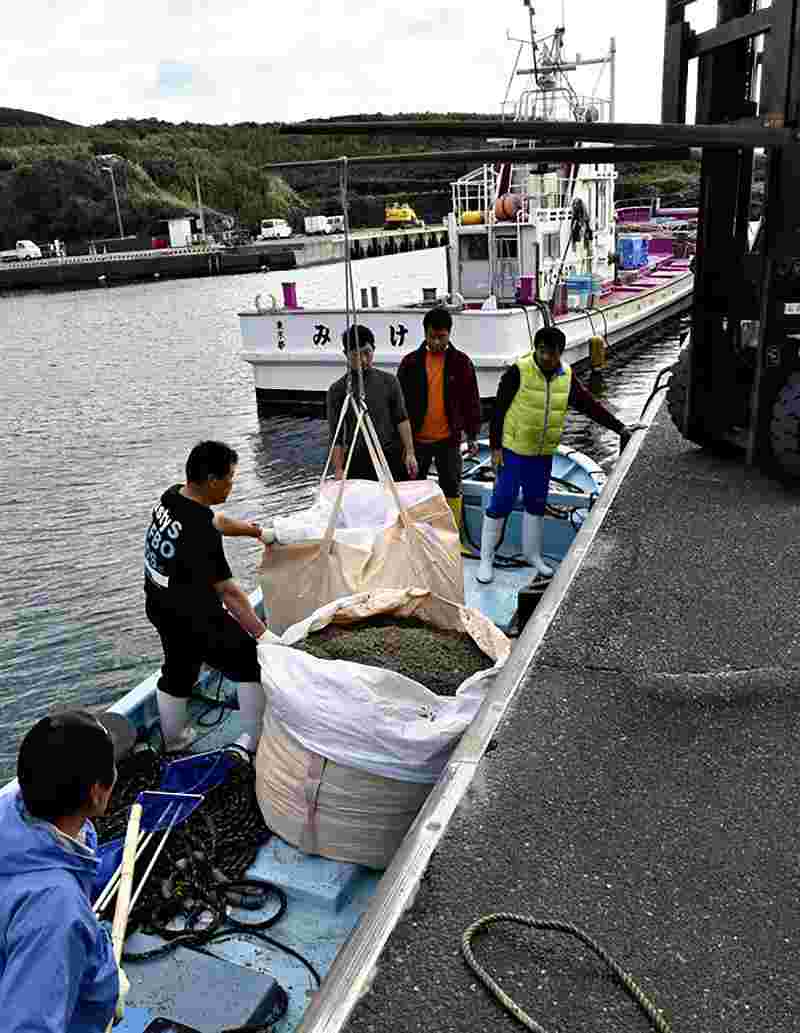
December 5, 2021
Floating pumice from the eruption of underwater volcano Fukutoku-Okanoba near the Ogasawara Islands has been washing ashore far to the north on the Izu Islands, where booms have been installed to prevent the pumice from flowing into fishing ports. As the fishermen gather up the floating pumice, however, many lament that there seems to be no end in sight to the inflow of volcanic debris.
On the morning of Nov. 29, fishermen on a boat just outside Ako fishing port on the western part of Miyakejima of the Izu Islands chain had nets in hand. They were scooping up floating pumice the size of grains of rice.
They patrolled mainly around concrete wave-dissipating blocks and collected enough pumice that a 1-ton sandbag was overflowing in just 30 minutes. The boat made two more rounds, filling six such sandbags.

Members of the Miyakejima fishermen’s cooperative bring ashore pumice stones they gathered on Nov. 29 at Ako fishing port in the village of Miyake, Tokyo.
On Nov. 20, the Tokyo metropolitan government, which administers the Izu Islands as well as the faraway Ogasawaras, had installed booms at Ako and four other locations on Miyakejima. Since fishing boats pump seawater to cool their engines, if the pumice gets stuck inside, it could cause the engine to overheat.
The booms, however, also prevent fishing vessels from leaving the port.
After the Miyakejima fishermen’s cooperative discussed the matter with the Tokyo metropolitan government, the booms were taken in temporarily so fishing could resume.
“We can’t let pumice enter the port,” said cooperative head Tsunemi Seki, 69, as he watched a fishing boat returning from scooping up pumice. “So we have to do everything we can to minimize the damage.”
The cooperative’s over 300 members remain worried about future developments.
In the predawn hours of Nov. 29, a 29-year-old member of the cooperative saw pumice floating on the surface of the water when he sailed around the north of the island to catch mackerel as bait for tuna fishing.
“If the engine overheats in the water far away from the island,” he said, “there will be no way to get back to the port on my own.”
Ferries also affected
Since Nov. 10, people have been checking for floating pumice around eight of the Izu Islands, including Miyakejima and Oshima, according to the Tokyo metropolitan government.
Based on estimates by the Japan Agency for Marine-Earth Science and Technology (JAMSTEC), the metropolitan government installed booms at 12 fishing ports across the islands of Kozushima, Mikurashima, Miyakejima, Niijima and Shikinejima. Drones are being used to monitor conditions, such as pumice being washed ashore.
In Okinawa Prefecture, where the arrival of pumice was confirmed in early October, the stones have spread throughout the prefecture, including islands further afield such as Ishigakijima and Miyakojima. This situation has been having a prolonged effect on the operation of fishing vessels and ferries.
Pumice has been confirmed at 26 ports as of Dec. 3, according to the Okinawa prefectural government. At seven of these, ferries and high-speed passenger vessels were canceled or operated on a different timetable. Some ports are still operating irregularly due to the effects of the stones. About 1,189 fishing boats, or 40% of all such vessels registered with the prefecture, have been refraining from fishing.
Agriculture, Forestry and Fisheries Minister Genjiro Kaneko said at a press conference after a Cabinet meeting on Nov. 30 that, as of that day, the pumice had been confirmed at 91 fishing ports in Kagoshima and Okinawa prefectures and the Izu Islands. Kaneko said that 168 fishing boats had had engine trouble and 49 had been crippled.
“We would like to closely watch the movements of pumice and the impact on fishing, and provide necessary support in a speedy manner,” Kaneko said.
As for the future movements of the floating pumice, Toru Miyama, a senior researcher at JAMSTEC specializing in physical oceanography, said: “Some pumice floating near Okinawa Prefecture will be carried by the Kuroshio current and spread widely across the Pacific Ocean, getting closer to the coasts of the Tokai and Kanto regions than ever before. I think the effects will last for at least two or three more months.”
Using pumice to adsorb cesium
There are moves to put the collected pumice to use.
A research team from the Kanagawa Institute of Industrial Science and Technology and other institutions announced that they had created from pumice zeolites, minerals used as adsorbents. Zeolites are used at the Tokyo Electric Power Company Holdings, Inc.’s Fukushima No.1 nuclear power plant to collect radioactive material. Zeolites have numerous holes of around 0.5 nanometers on the surface and adsorb materials such as radioactive cesium.
The research team aims to put the zeolites into practical use for that and other purposes.
The Okinawa prefectural government has been scooping up pumice using heavy machinery and transporting it to a temporary disposal site, but how to finally dispose of it is becoming an issue.
The research team focused on the fact that pumice contains aluminum and other materials that are ingredients for creating zeolites. They added pumice stones arriving on the shores of Yoron Island in Kagoshima Prefecture to alkaline aqueous solutions and heated the solutions at around 100 C, forming zeolites on the surface of the stones.
"Science & Nature" POPULAR ARTICLE
-

Mass Oyster Die-Offs Confirmed in Japan’s Seto Inland Sea; High Water Temperature Cited as Primary Cause
-

Genome Study Reveals Milestone in History of Cat Domestication
-

Big Leap in Quest to Get to Bottom of Climate Ice Mystery
-

Security Camera Footage Vulnerable to Outside Access; Investigation Finds 3,000 Pieces Exposed Online
-

Paws on Parade: Nairobi’s Dogs Dazzle at ‘Pawchella’
JN ACCESS RANKING
-

Keidanren Chairman Yoshinobu Tsutsui Visits Kashiwazaki-Kariwa Nuclear Power Plant; Inspects New Emergency Safety System
-

Imports of Rare Earths from China Facing Delays, May Be Caused by Deterioration of Japan-China Relations
-

University of Tokyo Professor Discusses Japanese Economic Security in Interview Ahead of Forum
-

Japan Pulls out of Vietnam Nuclear Project, Complicating Hanoi’s Power Plans
-

Govt Aims to Expand NISA Program Lineup, Abolish Age Restriction

























